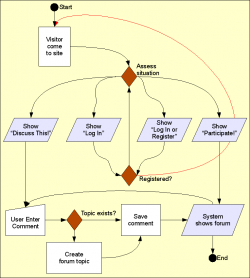
register
Brief Overview of CRISC Certification Exam
Sat, 06/23/2018 - 13:08 — Alexis WilkeThe CRISC, also known as Certified in Risk and Information Systems Control, is a vendor-neutral certification that validates a professional’s knowledge and experience in the fields of information system control & risk management. The certificate is developed and administered by ISACA and designed for the individuals who work with organizations in mitigating business risks and implement information system controls.
Organizations in today’s world must consistently enhance their infrastructure so that they can survive and thrive in today’s competitive environment. It is a ...
Drupal Aggregator
The default Aggregator Drupal module does not work very well. There are several problems with the Drupal Core module, one of which we have not fixed in our version (i.e. the flatness of the item table.)
There is a list of the known issues and our comments and whether we fixed the problem:
| Problem | Solution in m2osw's version of Aggregator |
|---|---|
| Missing XML marker | The <?xml ... ?> marker is missing from some RSS feeds, add it as required |
| Spurious data | Some RSS feeds add spurious data ... |
Discuss This! module Known Issues
The module works and is secure, however, there are problems difficult to circumvent. The following lists them. If you can help fixing some them, you'll be more than welcome!
Reordering the Comments on your Node
It is possible to reorder the node fields using the CCK module. If the Discuss This! comments do not appear exactly where you'd expect them to be, try using the the CCK module:
- Download the CCK module
- Install the CCK module
- Go to Administer » Content management » Content types
- Click on Manage content fields next to the node type you are ...
Discuss This! User Work Flow
Try
Declare a try/catch/finally block.
This has the behavior of the action script:
try { ... }
catch(name) { ... }
finally { ... }
In version 7, there are no definition of exceptions in the ActionScript interpreter. However, you can write functions that Throw.
The semantic of the try/catch/finally block is very well defined in ECMA 262 version 3 (see pages 87/88).
f_finally and f_catch may not both be zero or the semantic of the try block would be invalid. f_try_size, f_catch_size and f_finally_size are defined in bytes and give the size of each of the block of instructions just like a ...
Store Register
Pop one value from the stack, push it back on the stack and also store it in one of 4 or 256 registers which number is specified in the tag (0, 1, 2 or 3 only if not in a Declare Function (V7). I tried other numbers and they don't work in SWF version 6 or older.) Until set a register has the value undefined. The value of a register can be retrieved with a Push Data action and the register type with the matching register number.
Set Local Variable
Pop a value and a local variable name. Create or set a local variable of that name with the (initial) value as specified. The same local variable can safely be set in this way multiple times. To only declare a local variable (i.e. no default value to initialize the variable,) use the Declare Local Variable instead.
Note that the Get Variable action automatically gets a local variable if it exists. In order to still access a global variable, use the path syntax as in "/my_var".
Instead of local variables, it is also possible to use registers. There are 4 in Flash versions ...
Push Data
Push some immediate data on the stack. This action was introduced in V4.0. The supported data types vary depending on the version of the player you have. As many values as necessary can be pushed at once. The f_push_data structure will be repeated multiple times as required. For instance, to push two strings on the stack at once, you would use the following code:
96 0C 00 00 't' 'e' 's' 't' 00 00 'm' 'o' 'r' 'e' 00
Most of the time, it is a good idea to push more data and then use the Swap action to reorder. Extra PushData ...
Declare Object
Pop the number of members that will be created in the object. Pop one value and one name1 per member and set the corresponding member in the object. The resulting object is pushed on the stack. It can later be sent to a function, saved in a register or set in a variable.
- 1. The member names are converted to strings; they certainly should be strings though anything is supported.
Declare Function (V7)
Declare a function which can later be called with the Call Function action or Call Method action (when defined as a function member.) The f_function_length1 defines the number of bytes that the function declaration uses after the header (i.e. the size of the actions defined in the function.) All the actions included in this block are part of the function body.
- 1. A function is limited to 65535 bytes.

